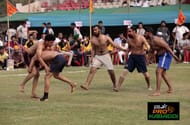Kabaddi is a contact sport which has different forms and types. For eg. the form of kabaddi which is played according to international rules followed by nations which actively participate in the sport. It also has various Indian styles, as it originated in ancient India thousands of years ago. The game Kabaddi has different indigenous rules followed in different parts of the country.
Some famous forms of the Indian style of Kabaddi are Amar, Punjabi, Sanjeevani, and Gaminee. Kabaddi is quite famous in South Asia, and is the national game of Bangladesh and Nepal.
In the international version of the game, two teams of seven members each participate and face against each other to emerge victorious, by collecting more points than their opponents. The size of the field in case of men is 10x13m, and the size of the field in case of women in 8x12m. Each team has three players in reserve, to be used as supplements if the situation demands. Each half of the game consists of 20 minutes, and a five minute break takes place at half time, when the teams exchange sides.
The teams take turns to send a raider into their opponents’ half, and to win a point, the raider must hold his breath, run into the opposition’s side, tag as many members as he can from the opposite team, and return back to his half before inhaling again. The raider is supposed to chant ‘kabaddi kabaddi’ with his exhaling breath, to show the referee that he isn’t breathing during his raid. The raider is declared out if he exhales during the raid or fails to come back to his half.
The tagged defenders of the opposite team will be declared out if they are not able to catch the raider before he comes back to his half, and their main objective is to wrestle the raider to the ground and hold him to make sure that he doesn’t escape. Defenders are not supposed to cross the center line, otherwise known as the lobby of the field, and the raider is not supposed to cross the boundary lines. However, there is one line, called the bonus line, which if touched by the raider grants him bonus points, if he successfully comes back to his half.
Players who have been pronounced out by the referee temporarily leave the field. Each time a player gets out, the opposition gains a point. If the entire opposing team is declared out, then a team is awarded three bonus points. At the end of the game, the team with the most number of points wins.
The Amateur Kabaddi Federation of India recognises four different forms of the sport. In Sanjeevani style of kabaddi, a player is revived if one player of the opposition is declared to be out. The total duration of the game is 40 minutes, with a five minute break in between the halves. Each team consists of seven players, and if a team manages to make the members of the opposite team out, then the team is given four extra points.
In the Gaminee style, seven players play on each side, and a player who has been pronounced to be out remains out of the game till his entire team has been declared to be out. The matches have no fixed duration, and the game continues till five or seven such points are scored. The Amar style of Kabaddi follows the same time frame rule as that of the Gaminee style, but a player who has been declared out stays in the field and the play goes on. For every player of the opposition tagged out, the team gains a point.
Circle style kabaddi
Punjabi Kabaddi is a form of kabaddi, which originated in Punjab. It is also called the Punjabi Circle style of kabaddi. It is played at state and international level and is governed by Amateur Circle Kabaddi Federation of India. It has various forms, like the Lambi Kabaddi, Saunchi Kabaddi, Goongi Kabaddi, 19 other traditional forms. The Punjabi form of kabaddi is followed in major international tournaments like the Kabaddi World Cup and the World Kabaddi League.
In Lambi Kabaddi, 15 players take part in a circular field of 15-20 feet. There is no outer limit or referee. The players can run for as far as they can. The raider has to say the words ‘kauddi kauddi’ while raiding his opponents. The other rules are similar to the Amar style of kabaddi.
Saunchi Kabaddi is very similar to boxing. It is popular in the Malwa region of Punjab. It has unlimited number of players, playing in a circular path. A bamboo is usually dug into the ground, with a red cloth around it. It is paraded by the winner. The raider hits the defender in this form of kabaddi, but only on the chest. The defender can hold the raider’s wrist if he does so, and a foul is committed if he grabs any other part of the body. If the defender holds the raider’s wrist and manages to subdue him, then he is declared as the winner. If the defender loses the grip and the raider escapes, then the raider is declared as the winner.
In the Goongi Kabaddi style, a raider does not speak and say out loud the word ‘Kauddi’, and just touches the opposition team’s player. Whichever player he touches is only supposed to try to wrestle him to the ground and stop him from going back to his half. If he gives up, then the point is given to the defender. If he is able to go back to his half and touch the line, then he is given the point.
With so many forms of kabaddi and a vast number of people participating in each, kabaddi is here to stay.

